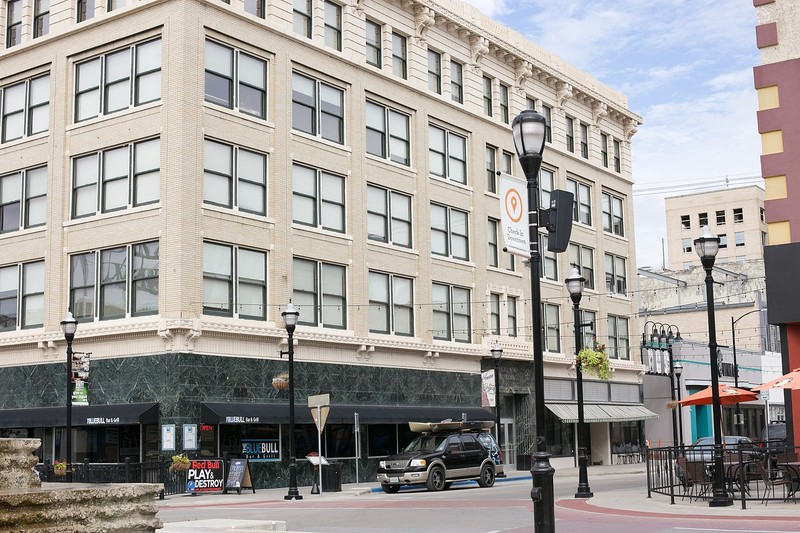Holland Building, Holland Family, and the Battle of Springfield
Introduction
Text-to-speech Audio
The typical narrative attached to the Holland Building is that Louise Holland Jarrett erected the building in honor of her exceptionally wealthy father and banker, Telmachus Blondville Holland. However, there is much more to the story. T.B. Holland's father (Louise's grandfather), Colley Blondville Holland, started the family-run bank in 1875 along with his two sons, the aforementioned Telmachus and W. C. Holland. Colley, though, was more than just a banker. Colley Holland also went by Brigadier Gen. Colley B. Holland, and he commanded the Missouri Militia during the Civil War. In 1863, Coley Holland played an integral role in defending Springfield, MO., against Confederate Gen. John Marmaduke in 1863; the historic battle lives in infamy as "The Battle of Springfield." It wasn't until after the Civil War that Colley established the bank with his sons, the success of which made Telmachus rich, allowing him to pass his fortune down to Louise, who in turn built the building in Telmachus' honor.
Images
Holland Building in Springfield, Missouri.

Backstory and Context
Text-to-speech Audio
The story of the Holland family begins like many early settlers of southern Missouri: A Tennessee pioneer moved to Missouri during the mid-nineteenth century, only a few years after the removal of the indigenous population and not long before the matter of slavery would lead to civil war. Colley B. Holland was born in Tennessee in 1816. Sadly, while still young, Colley lost his father and was forced to support his mom and siblings. As a young man in 1841, he moved with at least one brother to southwest Missouri. When they arrived, Greene County's population amounted to a little more than 5,300, but the county was much larger than it is today; people often lived nearly isolated lives in the hills of the Ozarks, including near Springfield.
Although the Holland family grew to become one of the wealthiest families in the area, Colley and his brother started their lives in the Ozarks humbly, opening a tailor shop shortly after emigrating from Tennessee. However, within a few years (1845), Colley found himself on the Springfield branch of the Missouri State Bank board of directors. In 1852, he worked as the Springfield Postmaster. By 1859, he served as one of the founders of the Springfield Male Academy, an educational institution. Thus, by the dawn of the Civil War, Colley Holland's influence in the county had grown immensely, just as the county had grown; Greene County's population in 1860 exceeded 13,000 people.
Although the Holland family came from Tennessee, Colley Holland openly declared his loyalty to the Union when the Civil War began. When President Abraham Lincoln called for volunteer soldiers in the Missouri region, Colley immediately joined, along with seventy-five thousand other men. Although he had some experience as a young, non-commissioned officer during the Seminole Wars of the late 1830s, little is known about how Holland grew into a high-ranking officer during the Civil War. Nevertheless, Colley Holland served as captain of Company D in the summer of 1861, became a lieutenant colonel in 1862, and then rose to the rank of brigadier general shortly thereafter. From his headquarters in Springfield, Missouri, he commanded the Missouri Militia throughout all of southwest Missouri. A few months later, in January 1863, Gen. Holland and his forces played an integral role in defending Springfield against the attack of Confederate Brigadier General John Sappington Marmaduke and his roughly 4,000 to 6,000 troops. (The details of that battle exceed the nature of this post, but links below can provide information on "The Battle of Springfield.").
The Holland name grew increasingly prominent in the Ozark Region, including Springfield. In 1875, Colley Holland established with his two sons, W.C. and Telmachus Blondville Holland, the Holland Banking Company. Its success allowed it to thrive during the 1890s, despite the Panic of 1893 and subsequent economic downturn. Various members of the Holland family embarked on numerous business ventures, from dairy farming and livestock to realty and banking, all of which made the family vastly wealthy. Telmachus served as president of the bank until he died in 1913; he left a tremendous amount of money and property to his daughter Louise Holland Jarrett.
In 1914, Springfield looked markedly different than when Louise's grandfather and father, Colley and Telmachus, arrived. Instead of a frontier town, Springfield acted as the commercial hub of southwest Missouri, with the Holland family playing a pivotal role in nurturing that growth. Springfield had grown from a town boasting of a mere 1,500 people in 1860 to nearly 40,000 in the 1910s. So, when Louise inherited the land from her father, she chose to erect an office building in her father's honor, an understandable choice and, one can argue, was an intelligent investment.
In the end, the Holland building speaks to the journey Colley Holland took from Tennessee to Springfield, Missouri, the role he played in the Battle of Springfield, and the concurrent evolution of the Holland family and Springfield from pioneer days to the Civil War to becoming a commercial center in the southwest Ozarks.
Sources
"Battle of Springfield." Community and Conflict: The Impact of the Civil War in the Ozarks.. https://ozarkscivilwar.org/archives/345
Fairbanks, Jonathan and Clyde Edwin Tuck. Past and Present of Greene County, Missouri. Volume I. Indianapolis: A.W. Bowen & Company, 1915.
"Remembering the Quinine Brigade and the Battle of Springfield." It's All Downtown. itsalldowntown.com. January 08, 2021. https://www.itsalldowntown.com/remembering-the-quinine-brigade-and-the-battle-of-springfield/.
Roberts, Anita L. Springfield, 1830-1930. Charleston, SC: Arcadia Publishing, 2011.
Yen, Connie. Springfield. Charleston, SC: Arcadia Publishing, 2022.
Sheals, Debbie. "Registration Form: Holland Building." National Register of Historic Places. mostateparks.com. 2000. https://mostateparks.com/sites/mostateparks/files/Holland%20Bldg.pdf.
State Historical Society of Missouri Research Center in Columbia. "The Enrolled Missouri Militia, 4th Military District, Order Book." Community and Conflict: The Impact of the Civil War in the Ozarks. https://ozarkscivilwar.org/archives/301.
By Joseph Bulger - Own work, CC BY-SA 3.0, https://commons.wikimedia.org/w/index.php?curid=36681185
